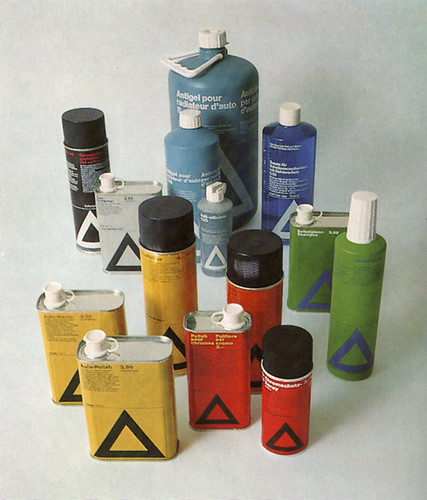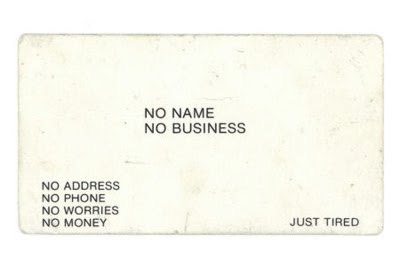Jul 31, 2011
Jul 29, 2011
Jul 28, 2011
Jul 26, 2011
Branding in the Digital Age: You’re Spending Your Money in All the Wrong Places
by David C. Edelman
via Harvard Business Review
The internet has upended how consumers engage with brands. It is transforming the economics of marketing and making obsolete many of the function’s traditional strategies and structures. For marketers, the old way of doing business is unsustainable.
Consider this: Not long ago, a car buyer would methodically pare down the available choices until he arrived at the one that best met his criteria. A dealer would reel him in and make the sale. The buyer’s relationship with both the dealer and the manufacturer would typically dissipate after the purchase. But today, consumers are promiscuous in their brand relationships: They connect with myriad brands—through new media channels beyond the manufacturer’s and the retailer’s control or even knowledge—and evaluate a shifting array of them, often expanding the pool before narrowing it. After a purchase these consumers may remain aggressively engaged, publicly promoting or assailing the products they’ve bought, collaborating in the brands’ development, and challenging and shaping their meaning.
Consumers still want a clear brand promise and offerings they value. What has changed is when—at what touch points—they are most open to influence, and how you can interact with them at those points. In the past, marketing strategies that put the lion’s share of resources into building brand awareness and then opening wallets at the point of purchase worked pretty well. But touch points have changed in both number and nature, requiring a major adjustment to realign marketers’ strategy and budgets with where consumers are actually spending their time.
Block That Metaphor
Marketers have long used the famous funnel metaphor to think about touch points: Consumers would start at the wide end of the funnel with many brands in mind and narrow them down to a final choice. Companies have traditionally used paid-media push marketing at a few well-defined points along the funnel to build awareness, drive consideration, and ultimately inspire purchase. But the metaphor fails to capture the shifting nature of consumer engagement.
In the June 2009 issue of McKinsey Quarterly, my colleague David Court and three coauthors introduced a more nuanced view of how consumers engage with brands: the “consumer decision journey” (CDJ). They developed their model from a study of the purchase decisions of nearly 20,000 consumers across five industries—automobiles, skin care, insurance, consumer electronics, and mobile telecom—and three continents. Their research revealed that far from systematically narrowing their choices, today’s consumers take a much more iterative and less reductive journey of four stages: consider, evaluate, buy, and enjoy, advocate, bond.
Consider.
The journey begins with the consumer’s top-of-mind consideration set: products or brands assembled from exposure to ads or store displays, an encounter at a friend’s house, or other stimuli. In the funnel model, the consider stage contains the largest number of brands; but today’s consumers, assaulted by media and awash in choices, often reduce the number of products they consider at the outset.
Evaluate.
The initial consideration set frequently expands as consumers seek input from peers, reviewers, retailers, and the brand and its competitors. Typically, they’ll add new brands to the set and discard some of the originals as they learn more and their selection criteria shift. Their outreach to marketers and other sources of information is much more likely to shape their ensuing choices than marketers’ push to persuade them.
Buy.
Increasingly, consumers put off a purchase decision until they’re actually in a store—and, as we’ll see, they may be easily dissuaded at that point. Thus point of purchase—which exploits placement, packaging, availability, pricing, and sales interactions—is an ever more powerful touch point.
Enjoy, advocate, bond.
After purchase, a deeper connection begins as the consumer interacts with the product and with new online touch points. More than 60% of consumers of facial skin care products, my McKinsey colleagues found, conduct online research about the products after purchase—a touch point entirely missing from the funnel. When consumers are pleased with a purchase, they’ll advocate for it by word of mouth, creating fodder for the evaluations of others and invigorating a brand’s potential. Of course, if a consumer is disappointed by the brand, she may sever ties with it—or worse. But if the bond becomes strong enough, she’ll enter an enjoy-advocate-buy loop that skips the consider and evaluate stages entirely.
The Journey in Practice
Although the basic premise of the consumer decision journey may not seem radical, its implications for marketing are profound. Two in particular stand out.
First, instead of focusing on how to allocate spending across media—television, radio, online, and so forth—marketers should target stages in the decision journey. The research my colleagues and I have done shows a mismatch between most marketing allocations and the touch points at which consumers are best influenced. Our analysis of dozens of marketing budgets reveals that 70% to 90% of spend goes to advertising and retail promotions that hit consumers at the consider and buy stages. Yet consumers are often influenced more during the evaluate and enjoy-advocate-bond stages. In many categories the single most powerful impetus to buy is someone else’s advocacy. Yet many marketers focus on media spend (principally advertising) rather than on driving advocacy. The coolest banner ads, best search buys, and hottest viral videos may win consideration for a brand, but if the product gets weak reviews—or, worse, isn’t even discussed online—it’s unlikely to survive the winnowing process.
The second implication is that marketers’ budgets are constructed to meet the needs of a strategy that is outdated. When the funnel metaphor reigned, communication was one-way, and every interaction with consumers had a variable media cost that typically outweighed creative’s fixed costs. Management focused on “working media spend”—the portion of a marketing budget devoted to what are today known as paid media.
This no longer makes sense. Now marketers must also consider owned media (that is, the channels a brand controls, such as websites) and earned media (customer-created channels, such as communities of brand enthusiasts). And an increasing portion of the budget must go to “nonworking” spend—the people and technology required to create and manage content for a profusion of channels and to monitor or participate in them.
Launching a Pilot
The shift to a CDJ-driven strategy has three parts: understanding your consumers’ decision journey; determining which touch points are priorities and how to leverage them; and allocating resources accordingly—an undertaking that may require redefining organizational relationships and roles.
One of McKinsey’s clients, a global consumer electronics company, embarked on a CDJ analysis after research revealed that although consumers were highly familiar with the brand, they tended to drop it from their consideration set as they got closer to purchase. It wasn’t clear exactly where the company was losing consumers or what should be done. What was clear was that the media-mix models the company had been using to allocate marketing spend at a gross level (like the vast majority of all such models) could not take the distinct goals of different touch points into account and strategically direct marketing investments to them.
The company decided to pilot a CDJ-based approach in one business unit in a single market, to launch a major new TV model. The chief marketing officer drove the effort, engaging senior managers at the start to facilitate coordination and ensure buy-in. The corporate VP for digital marketing shifted most of his time to the pilot, assembling a team with representatives from functions across the organization, including marketing, market research, IT, and, crucially, finance. The team began with an intensive three-month market research project to develop a detailed picture of how TV consumers navigate the decision journey: what they do, what they see, and what they say.
What they do.
Partnering with a supplier of online-consumer-panel data, the company identified a set of TV shoppers and drilled down into their behavior: How did they search? Did they show a preference for manufacturers’ or retailers’ sites? How did they participate in online communities? Next the team selected a sample of the shoppers for in-depth, one-on-one discussions: How would they describe the stages of their journey, online and off? Which resources were most valuable to them, and which were disappointing? How did brands enter and leave their decision sets, and what drove their purchases in the end?
The research confirmed some conventional wisdom about how consumers shop, but it also overturned some of the company’s long-standing assumptions. It revealed that off-line channels such as television advertising, in-store browsing, and direct word of mouth were influential only during the consider stage. Consumers might have a handful of products and brands in mind at this stage, with opinions about them shaped by previous experience, but their attitudes and consideration sets were extremely malleable. At the evaluate stage, consumers didn’t start with search engines; rather, they went directly to Amazon.com and other retail sites that, with their rich and expanding array of product-comparison information, consumer and expert ratings, and visuals, were becoming the most important influencers. Meanwhile, fewer than one in 10 shoppers visited manufacturers’ sites, where most companies were still putting the bulk of their digital spend. Display ads, which the team had assumed were important at the consider stage, were clicked on only if they contained a discount offer, and then only when the consumer was close to the buy stage. And although most consumers were still making their purchases in stores, a growing number were buying through retail sites and choosing either direct shipping or in-store pickup.
The research also illuminated consumers’ lively relationships with many brands after purchase—the enjoy-and-advocate stage so conspicuously absent from the funnel. These consumers often talked about their purchases in social networks and posted reviews online, particularly when they were stimulated by retailers’ postpurchase e-mails. And they tended to turn to review sites for troubleshooting advice.
What they see.
To better understand consumers’ experience, the team unleashed a battery of hired shoppers who were given individual assignments, such as to look for a TV for a new home; replace a small TV in a bedroom; or, after seeing a TV at a friend’s house, go online to learn more about it. The shoppers reported what their experience was like and how the company’s brand stacked up against competitors’. How did its TVs appear on search engines? How visible were they on retail sites? What did consumer reviews reveal about them? How thorough and accurate was the available information about them?
The results were alarming but not unexpected. Shoppers trying to engage with any of the brands—whether the company’s or its competitors’—had a highly fractured experience. Links constantly failed, because page designs and model numbers had changed but the references to them had not. Product reviews, though they were often positive, were scarce on retail sites. And the company’s TVs rarely turned up on the first page of a search within the category, in part because of the profusion of broken links. The same story had emerged during the one-on-one surveys. Consumers reported that every brand’s model numbers, product descriptions, promotion availability, and even pictures seemed to change as they moved across sites and into stores. About a third of the shoppers who had considered a specific TV brand online during the evaluate stage walked out of a store during the buy stage, confused and frustrated by inconsistencies.
This costly disruption of the journey across the category made clear that the company’s new marketing strategy had to deliver an integrated experience from consider to buy and beyond. In fact, because the problem was common to the entire category, addressing it might create competitive advantage. At any rate, there was little point in winning on the other touch-point battlegrounds if this problem was left unaddressed.
What they say.
Finally, the team focused on what people were saying online about the brand. With social media monitoring tools, it uncovered the key words consumers used to discuss the company’s products—and found deep confusion. Discussion-group participants frequently gave wrong answers because they misunderstood TV terminology. Product ratings and consumer recommendations sometimes triggered useful and extensive discussions, but when the ratings were negative, the conversation would often enter a self-reinforcing spiral. The company’s promotions got some positive response, but people mostly said little about the brand. This was a serious problem, because online advocacy is potent in the evaluate stage.
Taking Action
The company’s analysis made clear where its marketing emphasis needed to be. For the pilot launch, spending was significantly shifted away from paid media. Marketing inserted links from its own site to retail sites that carried the brand, working with the retailers to make sure the links connected seamlessly. Most important, click-stream analysis revealed that of all the online retailers, Amazon was probably the most influential touch point for the company’s products during the evaluate stage. In collaboration with sales, which managed the relationship with Amazon, marketing created content and links to engage traffic there. To encourage buzz, it aggressively distributed positive third-party reviews online and had its traditional media direct consumers to online environments that included promotions and social experiences. To build ongoing postpurchase relationships and encourage advocacy, it developed programs that included online community initiatives, contests, and e-mail promotions. Finally, to address the inconsistent descriptions and other messaging that was dissuading potential customers at the point of purchase, the team built a new content-development and -management system to ensure rigorous consistency across all platforms.
How did the CDJ strategy work? The new TV became the top seller on Amazon.com and the company’s best performer in retail stores, far exceeding the marketers’ expectations.
A Customer Experience Plan
As our case company found, a deep investigation of the decision journey often reveals the need for a plan that will make the customer’s experience coherent—and may extend the boundaries of the brand itself. The details of a customer experience plan will vary according to the company’s products, target segments, campaign strategy, and media mix. But when the plan is well executed, consumers’ perception of the brand will include everything from discussions in social media to the in-store shopping experience to continued interactions with the company and the retailer.
For instance, Apple has eliminated jargon, aligned product descriptions, created a rich library of explanatory videos, and instituted off-line Genius Bars, all of which ensure absolute consistency, accuracy, and integration across touch points. Similarly, Nike has moved from exhorting consumers to “Just Do It” to actually helping them act on its motto—with Nike+ gear that records and transmits their workout data; global fund-raising races; and customized online training programs. Thus its customers’ engagement with the brand doesn’t necessarily begin or end with a purchase. And millions of consumers in Japan have signed up to receive mobile alerts from McDonald’s, which provide tailored messages that include discount coupons, contest opportunities, special-event invitations, and other unique, brand-specific content.
These companies are not indiscriminate in their use of the tactics available for connecting with customers. Instead they customize their approaches according to their category, brand position, and channel relationships. Apple has not yet done much mining of its customer data to offer more-personalized messaging. Nike’s presence on search engines shows little distinctiveness. McDonald’s hasn’t focused on leveraging a core company website. But their decisions are deliberate, grounded in a clear sense of priorities.
New Roles for Marketing
Developing and executing a CDJ-centric strategy that drives an integrated customer experience requires marketing to take on new or expanded roles. Though we know of no company that has fully developed them, many, including the consumer electronics firm we advised, have begun to do so. Here are three roles that we believe will become increasingly important:
Orchestrator.
Many consumer touch points are owned-media channels, such as the company’s website, product packaging, and customer service and sales functions. Usually they are run by parts of the organization other than marketing. Recognizing the need to coordinate these channels, one of our clients, a consumer durables company, has moved its owned-media functions into the sphere of the chief marketing officer, giving him responsibility for orchestrating them. Along with traditional and digital marketing communications, he now manages customer service and market research, product literature design, and the product registration and warranty program.
Publisher and “content supply chain” manager.
Marketers are generating ever-escalating amounts of content, often becoming publishers—sometimes real-time multimedia publishers—on a global scale. They create videos for marketing, selling, and servicing every product; coupons and other promotions delivered through social media; applications and decision support such as tools to help customers “build” and price a car online. One of our clients, a consumer marketer, realized that every new product release required it to create more than 160 pieces of content involving more than 20 different parties and reaching 30 different touch points. Without careful coordination, producing this volume of material was guaranteed to be inefficient and invited inconsistent messaging that would undermine the brand. As we sought best practices, we discovered that few companies have created the roles and systems needed to manage their content supply chain and create a coherent consumer experience. Uncoordinated publishing can stall the decision journey, as the consumer electronics firm found. Our research shows that in companies where the marketing function takes on the role of publisher in chief—rationalizing the creation and flow of product related content—consumers develop a clearer sense of the brand and are better able to articulate the attributes of specific products. These marketers also become more agile with their content, readily adapting it to sales training videos and other new uses that ultimately enhance consumers’ decision journey.
Marketplace intelligence leader.
As more touch points become digital, opportunities to collect and use customer information to understand the consumer decision journey and knit together the customer experience are increasing. But in many companies IT controls the collection and management of data and the relevant budgets; and with its traditional focus on driving operational efficiency, it often lacks the strategic or financial perspective that would incline it to steer resources toward marketing goals.
More than ever, marketing data should be under marketing’s control. One global bank offers a model: It created a Digital Governance Council with representatives from all customer-facing functions. The council is led by the CMO, who articulates the strategy, and attended by the CIO, who lays out options for executing it and receives direction and funding from the council.
We believe that marketing will increasingly take a lead role in distributing customer insights across the organization. For example, discoveries about “what the customer says” as she navigates the CDJ may be highly relevant to product development or service programs. Marketing should convene the right people in the organization to act on its consumer insights and should manage the follow-up to ensure that the enterprise takes action.
Starting the Journey
The firms we advise that are taking this path tend to begin with a narrow line of business or geography (or both) where they can develop a clear understanding of one consumer decision journey and then adjust strategy and resources accordingly. As their pilots get under way, companies inevitably encounter challenges they can’t fully address at the local level—such as a need for new enterprisewide infrastructure to support a content management system. Or they may have to adapt the design of a social media program to better suit the narrow initiative. In the more successful initiatives we’ve seen, the CMO has championed the pilot before the executive leadership team. The best results come when a bottom-up pilot is paralleled by a top-down CMO initiative to address cross-functional, infrastructure, and organizational challenges.
Finally, a company must capture processes, successes, and failures when it launches a pilot so that the pilot can be effectively adapted and scaled. A key consideration is that although the basic architecture of a CDJ strategy may remain intact as it is expanded, specific tactics will probably vary from one market and product to another. When the consumer electronics firm discussed here took its CDJ strategy to East Asia, for example, its touch-point analysis revealed that consumers in that part of the world put more stock in blogs and third-party review sites than Western consumers do, and less in manufacturers’ or retailers’ sites, which they didn’t fully trust. They were also less likely to buy online. However, they relied more on mobile apps such as bar-code readers to pull up detailed product information at the point of purchase.
The changes buffeting marketers in the digital era are not incremental—they are fundamental. Consumers’ perception of a brand during the decision journey has always been important, but the phenomenal reach, speed, and interactivity of digital touch points makes close attention to the brand experience essential—and requires an executive-level steward. At many start-ups the founder brings to this role the needed vision and the power to enforce it. Established enterprises should have a steward as well. Now is the time for CMOs to seize this opportunity to take on a leadership role, establishing a stronger position in the executive suite and making consumers’ brand experience central to enterprise strategy.
by David C. Edelman
via Harvard Business Review
The internet has upended how consumers engage with brands. It is transforming the economics of marketing and making obsolete many of the function’s traditional strategies and structures. For marketers, the old way of doing business is unsustainable.
Consider this: Not long ago, a car buyer would methodically pare down the available choices until he arrived at the one that best met his criteria. A dealer would reel him in and make the sale. The buyer’s relationship with both the dealer and the manufacturer would typically dissipate after the purchase. But today, consumers are promiscuous in their brand relationships: They connect with myriad brands—through new media channels beyond the manufacturer’s and the retailer’s control or even knowledge—and evaluate a shifting array of them, often expanding the pool before narrowing it. After a purchase these consumers may remain aggressively engaged, publicly promoting or assailing the products they’ve bought, collaborating in the brands’ development, and challenging and shaping their meaning.
Consumers still want a clear brand promise and offerings they value. What has changed is when—at what touch points—they are most open to influence, and how you can interact with them at those points. In the past, marketing strategies that put the lion’s share of resources into building brand awareness and then opening wallets at the point of purchase worked pretty well. But touch points have changed in both number and nature, requiring a major adjustment to realign marketers’ strategy and budgets with where consumers are actually spending their time.
Block That Metaphor
Marketers have long used the famous funnel metaphor to think about touch points: Consumers would start at the wide end of the funnel with many brands in mind and narrow them down to a final choice. Companies have traditionally used paid-media push marketing at a few well-defined points along the funnel to build awareness, drive consideration, and ultimately inspire purchase. But the metaphor fails to capture the shifting nature of consumer engagement.
In the June 2009 issue of McKinsey Quarterly, my colleague David Court and three coauthors introduced a more nuanced view of how consumers engage with brands: the “consumer decision journey” (CDJ). They developed their model from a study of the purchase decisions of nearly 20,000 consumers across five industries—automobiles, skin care, insurance, consumer electronics, and mobile telecom—and three continents. Their research revealed that far from systematically narrowing their choices, today’s consumers take a much more iterative and less reductive journey of four stages: consider, evaluate, buy, and enjoy, advocate, bond.
Consider.
The journey begins with the consumer’s top-of-mind consideration set: products or brands assembled from exposure to ads or store displays, an encounter at a friend’s house, or other stimuli. In the funnel model, the consider stage contains the largest number of brands; but today’s consumers, assaulted by media and awash in choices, often reduce the number of products they consider at the outset.
Evaluate.
The initial consideration set frequently expands as consumers seek input from peers, reviewers, retailers, and the brand and its competitors. Typically, they’ll add new brands to the set and discard some of the originals as they learn more and their selection criteria shift. Their outreach to marketers and other sources of information is much more likely to shape their ensuing choices than marketers’ push to persuade them.
Buy.
Increasingly, consumers put off a purchase decision until they’re actually in a store—and, as we’ll see, they may be easily dissuaded at that point. Thus point of purchase—which exploits placement, packaging, availability, pricing, and sales interactions—is an ever more powerful touch point.
Enjoy, advocate, bond.
After purchase, a deeper connection begins as the consumer interacts with the product and with new online touch points. More than 60% of consumers of facial skin care products, my McKinsey colleagues found, conduct online research about the products after purchase—a touch point entirely missing from the funnel. When consumers are pleased with a purchase, they’ll advocate for it by word of mouth, creating fodder for the evaluations of others and invigorating a brand’s potential. Of course, if a consumer is disappointed by the brand, she may sever ties with it—or worse. But if the bond becomes strong enough, she’ll enter an enjoy-advocate-buy loop that skips the consider and evaluate stages entirely.
The Journey in Practice
Although the basic premise of the consumer decision journey may not seem radical, its implications for marketing are profound. Two in particular stand out.
First, instead of focusing on how to allocate spending across media—television, radio, online, and so forth—marketers should target stages in the decision journey. The research my colleagues and I have done shows a mismatch between most marketing allocations and the touch points at which consumers are best influenced. Our analysis of dozens of marketing budgets reveals that 70% to 90% of spend goes to advertising and retail promotions that hit consumers at the consider and buy stages. Yet consumers are often influenced more during the evaluate and enjoy-advocate-bond stages. In many categories the single most powerful impetus to buy is someone else’s advocacy. Yet many marketers focus on media spend (principally advertising) rather than on driving advocacy. The coolest banner ads, best search buys, and hottest viral videos may win consideration for a brand, but if the product gets weak reviews—or, worse, isn’t even discussed online—it’s unlikely to survive the winnowing process.
The second implication is that marketers’ budgets are constructed to meet the needs of a strategy that is outdated. When the funnel metaphor reigned, communication was one-way, and every interaction with consumers had a variable media cost that typically outweighed creative’s fixed costs. Management focused on “working media spend”—the portion of a marketing budget devoted to what are today known as paid media.
This no longer makes sense. Now marketers must also consider owned media (that is, the channels a brand controls, such as websites) and earned media (customer-created channels, such as communities of brand enthusiasts). And an increasing portion of the budget must go to “nonworking” spend—the people and technology required to create and manage content for a profusion of channels and to monitor or participate in them.
Launching a Pilot
The shift to a CDJ-driven strategy has three parts: understanding your consumers’ decision journey; determining which touch points are priorities and how to leverage them; and allocating resources accordingly—an undertaking that may require redefining organizational relationships and roles.
One of McKinsey’s clients, a global consumer electronics company, embarked on a CDJ analysis after research revealed that although consumers were highly familiar with the brand, they tended to drop it from their consideration set as they got closer to purchase. It wasn’t clear exactly where the company was losing consumers or what should be done. What was clear was that the media-mix models the company had been using to allocate marketing spend at a gross level (like the vast majority of all such models) could not take the distinct goals of different touch points into account and strategically direct marketing investments to them.
The company decided to pilot a CDJ-based approach in one business unit in a single market, to launch a major new TV model. The chief marketing officer drove the effort, engaging senior managers at the start to facilitate coordination and ensure buy-in. The corporate VP for digital marketing shifted most of his time to the pilot, assembling a team with representatives from functions across the organization, including marketing, market research, IT, and, crucially, finance. The team began with an intensive three-month market research project to develop a detailed picture of how TV consumers navigate the decision journey: what they do, what they see, and what they say.
What they do.
Partnering with a supplier of online-consumer-panel data, the company identified a set of TV shoppers and drilled down into their behavior: How did they search? Did they show a preference for manufacturers’ or retailers’ sites? How did they participate in online communities? Next the team selected a sample of the shoppers for in-depth, one-on-one discussions: How would they describe the stages of their journey, online and off? Which resources were most valuable to them, and which were disappointing? How did brands enter and leave their decision sets, and what drove their purchases in the end?
The research confirmed some conventional wisdom about how consumers shop, but it also overturned some of the company’s long-standing assumptions. It revealed that off-line channels such as television advertising, in-store browsing, and direct word of mouth were influential only during the consider stage. Consumers might have a handful of products and brands in mind at this stage, with opinions about them shaped by previous experience, but their attitudes and consideration sets were extremely malleable. At the evaluate stage, consumers didn’t start with search engines; rather, they went directly to Amazon.com and other retail sites that, with their rich and expanding array of product-comparison information, consumer and expert ratings, and visuals, were becoming the most important influencers. Meanwhile, fewer than one in 10 shoppers visited manufacturers’ sites, where most companies were still putting the bulk of their digital spend. Display ads, which the team had assumed were important at the consider stage, were clicked on only if they contained a discount offer, and then only when the consumer was close to the buy stage. And although most consumers were still making their purchases in stores, a growing number were buying through retail sites and choosing either direct shipping or in-store pickup.
The research also illuminated consumers’ lively relationships with many brands after purchase—the enjoy-and-advocate stage so conspicuously absent from the funnel. These consumers often talked about their purchases in social networks and posted reviews online, particularly when they were stimulated by retailers’ postpurchase e-mails. And they tended to turn to review sites for troubleshooting advice.
What they see.
To better understand consumers’ experience, the team unleashed a battery of hired shoppers who were given individual assignments, such as to look for a TV for a new home; replace a small TV in a bedroom; or, after seeing a TV at a friend’s house, go online to learn more about it. The shoppers reported what their experience was like and how the company’s brand stacked up against competitors’. How did its TVs appear on search engines? How visible were they on retail sites? What did consumer reviews reveal about them? How thorough and accurate was the available information about them?
The results were alarming but not unexpected. Shoppers trying to engage with any of the brands—whether the company’s or its competitors’—had a highly fractured experience. Links constantly failed, because page designs and model numbers had changed but the references to them had not. Product reviews, though they were often positive, were scarce on retail sites. And the company’s TVs rarely turned up on the first page of a search within the category, in part because of the profusion of broken links. The same story had emerged during the one-on-one surveys. Consumers reported that every brand’s model numbers, product descriptions, promotion availability, and even pictures seemed to change as they moved across sites and into stores. About a third of the shoppers who had considered a specific TV brand online during the evaluate stage walked out of a store during the buy stage, confused and frustrated by inconsistencies.
This costly disruption of the journey across the category made clear that the company’s new marketing strategy had to deliver an integrated experience from consider to buy and beyond. In fact, because the problem was common to the entire category, addressing it might create competitive advantage. At any rate, there was little point in winning on the other touch-point battlegrounds if this problem was left unaddressed.
What they say.
Finally, the team focused on what people were saying online about the brand. With social media monitoring tools, it uncovered the key words consumers used to discuss the company’s products—and found deep confusion. Discussion-group participants frequently gave wrong answers because they misunderstood TV terminology. Product ratings and consumer recommendations sometimes triggered useful and extensive discussions, but when the ratings were negative, the conversation would often enter a self-reinforcing spiral. The company’s promotions got some positive response, but people mostly said little about the brand. This was a serious problem, because online advocacy is potent in the evaluate stage.
Taking Action
The company’s analysis made clear where its marketing emphasis needed to be. For the pilot launch, spending was significantly shifted away from paid media. Marketing inserted links from its own site to retail sites that carried the brand, working with the retailers to make sure the links connected seamlessly. Most important, click-stream analysis revealed that of all the online retailers, Amazon was probably the most influential touch point for the company’s products during the evaluate stage. In collaboration with sales, which managed the relationship with Amazon, marketing created content and links to engage traffic there. To encourage buzz, it aggressively distributed positive third-party reviews online and had its traditional media direct consumers to online environments that included promotions and social experiences. To build ongoing postpurchase relationships and encourage advocacy, it developed programs that included online community initiatives, contests, and e-mail promotions. Finally, to address the inconsistent descriptions and other messaging that was dissuading potential customers at the point of purchase, the team built a new content-development and -management system to ensure rigorous consistency across all platforms.
How did the CDJ strategy work? The new TV became the top seller on Amazon.com and the company’s best performer in retail stores, far exceeding the marketers’ expectations.
A Customer Experience Plan
As our case company found, a deep investigation of the decision journey often reveals the need for a plan that will make the customer’s experience coherent—and may extend the boundaries of the brand itself. The details of a customer experience plan will vary according to the company’s products, target segments, campaign strategy, and media mix. But when the plan is well executed, consumers’ perception of the brand will include everything from discussions in social media to the in-store shopping experience to continued interactions with the company and the retailer.
For instance, Apple has eliminated jargon, aligned product descriptions, created a rich library of explanatory videos, and instituted off-line Genius Bars, all of which ensure absolute consistency, accuracy, and integration across touch points. Similarly, Nike has moved from exhorting consumers to “Just Do It” to actually helping them act on its motto—with Nike+ gear that records and transmits their workout data; global fund-raising races; and customized online training programs. Thus its customers’ engagement with the brand doesn’t necessarily begin or end with a purchase. And millions of consumers in Japan have signed up to receive mobile alerts from McDonald’s, which provide tailored messages that include discount coupons, contest opportunities, special-event invitations, and other unique, brand-specific content.
These companies are not indiscriminate in their use of the tactics available for connecting with customers. Instead they customize their approaches according to their category, brand position, and channel relationships. Apple has not yet done much mining of its customer data to offer more-personalized messaging. Nike’s presence on search engines shows little distinctiveness. McDonald’s hasn’t focused on leveraging a core company website. But their decisions are deliberate, grounded in a clear sense of priorities.
New Roles for Marketing
Developing and executing a CDJ-centric strategy that drives an integrated customer experience requires marketing to take on new or expanded roles. Though we know of no company that has fully developed them, many, including the consumer electronics firm we advised, have begun to do so. Here are three roles that we believe will become increasingly important:
Orchestrator.
Many consumer touch points are owned-media channels, such as the company’s website, product packaging, and customer service and sales functions. Usually they are run by parts of the organization other than marketing. Recognizing the need to coordinate these channels, one of our clients, a consumer durables company, has moved its owned-media functions into the sphere of the chief marketing officer, giving him responsibility for orchestrating them. Along with traditional and digital marketing communications, he now manages customer service and market research, product literature design, and the product registration and warranty program.
Publisher and “content supply chain” manager.
Marketers are generating ever-escalating amounts of content, often becoming publishers—sometimes real-time multimedia publishers—on a global scale. They create videos for marketing, selling, and servicing every product; coupons and other promotions delivered through social media; applications and decision support such as tools to help customers “build” and price a car online. One of our clients, a consumer marketer, realized that every new product release required it to create more than 160 pieces of content involving more than 20 different parties and reaching 30 different touch points. Without careful coordination, producing this volume of material was guaranteed to be inefficient and invited inconsistent messaging that would undermine the brand. As we sought best practices, we discovered that few companies have created the roles and systems needed to manage their content supply chain and create a coherent consumer experience. Uncoordinated publishing can stall the decision journey, as the consumer electronics firm found. Our research shows that in companies where the marketing function takes on the role of publisher in chief—rationalizing the creation and flow of product related content—consumers develop a clearer sense of the brand and are better able to articulate the attributes of specific products. These marketers also become more agile with their content, readily adapting it to sales training videos and other new uses that ultimately enhance consumers’ decision journey.
Marketplace intelligence leader.
As more touch points become digital, opportunities to collect and use customer information to understand the consumer decision journey and knit together the customer experience are increasing. But in many companies IT controls the collection and management of data and the relevant budgets; and with its traditional focus on driving operational efficiency, it often lacks the strategic or financial perspective that would incline it to steer resources toward marketing goals.
More than ever, marketing data should be under marketing’s control. One global bank offers a model: It created a Digital Governance Council with representatives from all customer-facing functions. The council is led by the CMO, who articulates the strategy, and attended by the CIO, who lays out options for executing it and receives direction and funding from the council.
We believe that marketing will increasingly take a lead role in distributing customer insights across the organization. For example, discoveries about “what the customer says” as she navigates the CDJ may be highly relevant to product development or service programs. Marketing should convene the right people in the organization to act on its consumer insights and should manage the follow-up to ensure that the enterprise takes action.
Starting the Journey
The firms we advise that are taking this path tend to begin with a narrow line of business or geography (or both) where they can develop a clear understanding of one consumer decision journey and then adjust strategy and resources accordingly. As their pilots get under way, companies inevitably encounter challenges they can’t fully address at the local level—such as a need for new enterprisewide infrastructure to support a content management system. Or they may have to adapt the design of a social media program to better suit the narrow initiative. In the more successful initiatives we’ve seen, the CMO has championed the pilot before the executive leadership team. The best results come when a bottom-up pilot is paralleled by a top-down CMO initiative to address cross-functional, infrastructure, and organizational challenges.
Finally, a company must capture processes, successes, and failures when it launches a pilot so that the pilot can be effectively adapted and scaled. A key consideration is that although the basic architecture of a CDJ strategy may remain intact as it is expanded, specific tactics will probably vary from one market and product to another. When the consumer electronics firm discussed here took its CDJ strategy to East Asia, for example, its touch-point analysis revealed that consumers in that part of the world put more stock in blogs and third-party review sites than Western consumers do, and less in manufacturers’ or retailers’ sites, which they didn’t fully trust. They were also less likely to buy online. However, they relied more on mobile apps such as bar-code readers to pull up detailed product information at the point of purchase.
The changes buffeting marketers in the digital era are not incremental—they are fundamental. Consumers’ perception of a brand during the decision journey has always been important, but the phenomenal reach, speed, and interactivity of digital touch points makes close attention to the brand experience essential—and requires an executive-level steward. At many start-ups the founder brings to this role the needed vision and the power to enforce it. Established enterprises should have a steward as well. Now is the time for CMOs to seize this opportunity to take on a leadership role, establishing a stronger position in the executive suite and making consumers’ brand experience central to enterprise strategy.
Jul 25, 2011
Jul 20, 2011
Jul 18, 2011

너의 의지에 의지하다
Leaning on(against) Your Will
Daehyun Kim
29.5 x 42cm, Marker and pen on the paper, 2009
via Acrosstheunivers
Labels:
art
Jul 16, 2011
Jul 13, 2011
Jul 12, 2011

Fields Notes American Tradesman Edition
Printed 6/11, Edition size: 15,000 books
Our 11th COLORS edition features a Neenah 120# duplex cover, “Indigo Blue” on the outside with a vertical linear finish and “Jefferson Nickel” metallic silver type. The inside cover is a smooth “Avalanche White” printed in “Concord Red.” The inside paper is 50# Finch Opaque printed with a light cool-gray graph. 3-Pack includes a sturdy 7″ carpenter pencil and a Field Notes Workshop Reference Card featuring instructions for sharpening.
Get yours here now before it sells out.
Labels:
design
,
stationery
Jul 11, 2011
Jul 10, 2011

Vogue Italia Interviews Aaron Bondaroff of OH-WOW Gallery
Watch the interview here
Image via OH-WOW NET WORK
Jul 8, 2011
Jul 7, 2011
Jul 2, 2011

Salvador Dali and His Wife Gala Go Sailing with a Friend
from FT Weekend Column [My Perfect Getaway]
click here to read full column
Subscribe to:
Posts
(
Atom
)

































